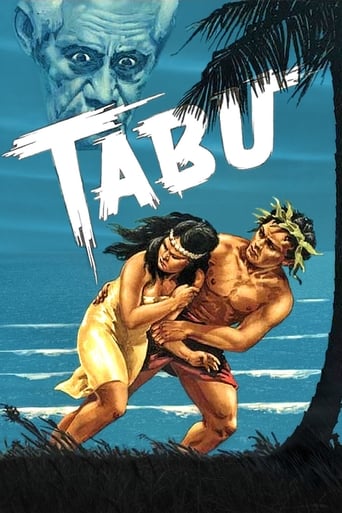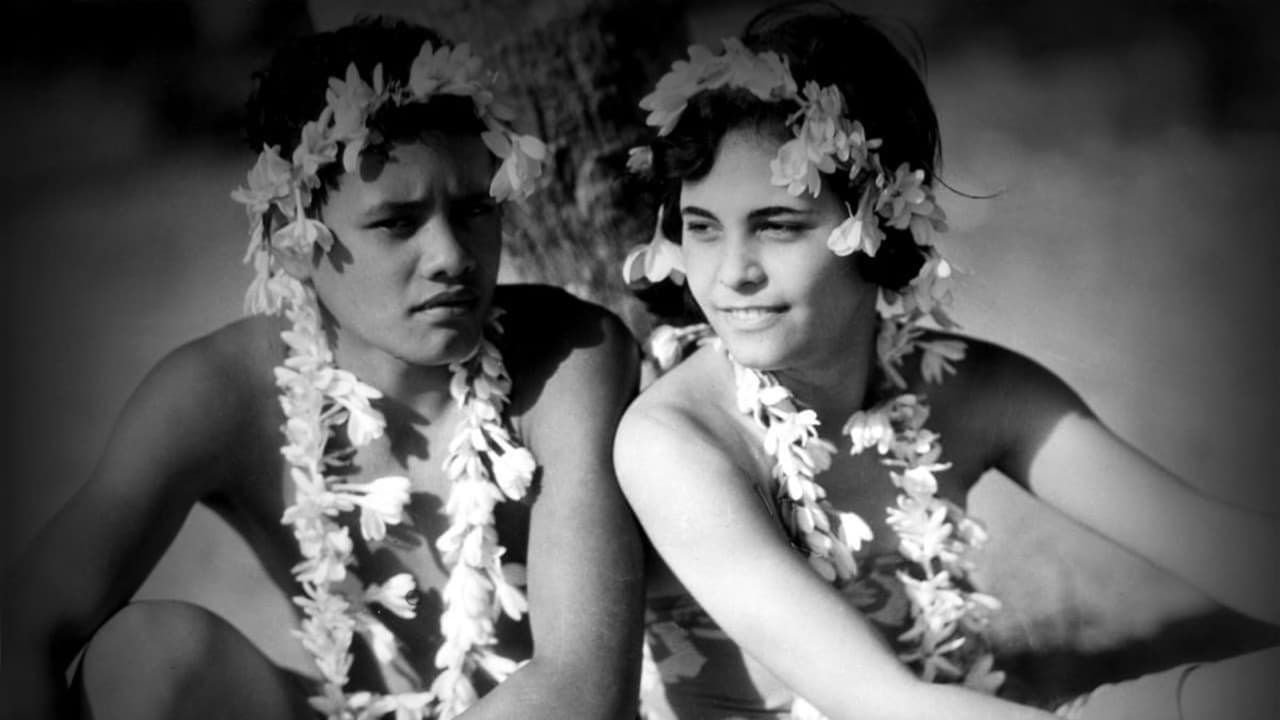JohnHowardReid
Anna Chevalier (Reri, the young girl), Matahi (the young man), Hitu (old warrior), Jean (policeman), Jules (captain), Ah Fong (Chinese trader).Written, produced and directed by F. W. MURNAU and ROBERT J. FLAHERTY. Photography: Floyd Crosby. Film editor: Arthur A. Brooks. Supervising film editor and production manager: Edgar G. Ulmer. Music: Hugo Riesenfeld. Co-producer: David Flaherty. Assistant director: Bill Bambridge. Music orchestrations: W. Franke Harling and Milan Roder. Not copyright by Murnau-Flaherty Productions. Released through Paramount. New York opening at the Central Park Theatre, 18 March 1931. 6 reels. 81 minutes.SYNOPSIS: Native boy loves Sacred Maiden.NOTES: Academy Award for Cinematography. (Floyd Crosby defeated a strong field, including Edward Cronjager's Cimarron, Lee Garmes' Morocco, Charles Lang's The Right To Love and Barney McGill's Svengali). Filmed over a period of 18 months in the South Seas, on the islands of Bora Bora and Takapota, "Tabu" is a silent film, with a synchronized music score and sound effects.Flaherty disclaims the film. He withdrew from the production before it was completed.On the Thursday before the New York opening, F. W. Murnau was killed when his driver lost control of his car and it plunged over an embankment on the outskirts of Los Angeles.COMMENT: The trailer (which Paramount prepared well before the director's death) tells us that over a thousand critics had voted Murnau as one of the world's greatest directors. His first Hollywood feature, Sunrise (1927), certainly achieved triumphant status. Basically, a silent film, it was fleshed out with sound effects and a wonderful music score by Hugo Riesenfeld. However, Murnau's next pictures, Four Devils (1929) and City Girl (1930), failed to achieve comparable success, both with the critics and public. Again, both were basically conceived as silent films, though this time with talking sequences. Murnau had little to do with the talkie sections. In both films, these were "staged" by A.H. Van Buren and A.F. "Buddy" Erickson.When producer William Fox decided to expand the dialogue content of City Girl, Murnau left the production and Buddy Erickson took over the direction.Murnau then formed a partnership with the famous documentary film- maker, Bob Flaherty. Together they journeyed to the South Seas, to the island of Bora Bora, then untouched by the "advances" of civilization. They wrote a simple but emotive script that brilliantly utilized their surroundings and commenced filming with an all-native cast, headed by the lovely Anna Chevalier (who is actually billed as "Reri" to disguise her French parentage).At some stage, Murnau and Flaherty had a serious disagreement. In the upshot, Flaherty left Bora Bora. Murnau completed the film by himself, then took the rushes back to Hollywood where he supervised the editing in collaboration with his friend, Edgar G. Ulmer. Another friend, Hugo Riesenfeld, wrote the magnificent music that underlines just about every minute of the movie's running time, deftly inserting traditional native chants to add poetry, realism and variety.It's about the music score that I want to speak first. One of the most remarkable and beautiful scores ever written for a motion picture, it is so wondrously atmospheric that the viewer doesn't realize that the composer also supplies all the sound effects until a second or third viewing. The love theme is heart-wrenching and poignant. By a happy chance, this style of scoring with its repetitive phrases and crescendo orchestration was later used extensively by Alfred Newman. So, unlike many other early 1930s scores, this one seems astonishingly "modern".Although not a single word of spoken dialogue issues from the screen, we never have the impression of watching a silent film. Cleverly, the usual insert captions are used most sparingly, and even then only (and quite naturally) employed to reveal the contents of three or four letters.Under Murnau's inspired guidance, the acting of this entirely amateur cast rates as nothing short of superlative. The players come across with such complete conviction, they seem for all the world like real people playing out this tragic romance before our very eyes.Finally, the photography. Yes, Floyd Crosby certainly deserved his award. Every single shot strikes the viewer as a masterpiece of composition, lighting and atmosphere. It positively shimmers. So many superlatively dramatic and/or picturesquely riveting shots continuously catch the eyes, it's impossible to even begin listing just the highlights.Tabu is a picture that alternately moves, inspires, delights and saddens. Its overpoweringly realistic story, cloaked with imagery that heightens the senses, has not lost its impact today. If anything, it has gained in stature and importance.
mark.waltz
A stunning docudrama takes the beautiful landscapes of Bora Bora and turns it into a visual paradise to drool over. Absolutely stunning and sumptuous in every way, this shows the every day play and work of the happy go lucky south sea natives and the growing love between a young man and girl, threatened to be separated forever when it is commanded by the order of the local chief that she be made the honorary virgin of the volcano, untouched by man. Any attempts to take away the virgin or deflower her is a curse for all, but young love, even among the superstitious allows no such circumstance to be separated, putting the two on the run for their lives.Ending up on a nearby port, the two lovers do their best to hide from those looking for them, even having fun in a modern native dance, nothing like they've ever seen before. But the dangers are constantly looming, every glance at them is a risk of being caught, and that keeps this flowing with excitement at breakneck speed. The attractive, barely covered cast does a great job without dialog, the only narration being a series of letters to indicate the passage of time and to reveal the most important if details. This is F.W. Murnau's masterpiece, filled with reminders of the dangers these free loving people faced, through nature, through superstition, through chance. The Kino DVD features an extremely memorable musical score that really helps the emotions of the film tell the story until its completion.
Boba_Fett1138
The movie is no way near as a good as Murnau's most previous movies, mainly because it isn't really anything innovation. For his standards, this is a pretty standard piece of work. This no doubt also has to do with the fact that during the beginning of production acclaimed documentary maker Robert J. Flaherty (the man who also made "Nanook of the North") was also at the helm but slowly got pushed away by F.W. Murnau as filming progressed. Two captains on one ship just never work out, especially not when they have different expertise's. It's the reason why the movie at times looks as if its a documentary about the natives and at others the movie follows obviously a story. But having said that this is no way near close to being F.W. Murnau's best, says nothing about the quality of this actual film. It's a worthy enough last picture of the German director, who gave us movies such as "Nosferatu, eine Symphonie des Grauens", "Der Letzte Mann" and "Faust", before dying in a car crash, one week before the release of this movie. He was one of the most influential directors of the silent film era, even though this last movie doesn't fully does justice to this reputation.The movie just wasn't always much interesting to me. Perhaps I just didn't liked or cared enough about its subject of a group of natives on Bora-Bora. The movie of course looks visually good and shows lot of the customs and lifestyle of the natives but the story just doesn't ever get off the ground. Perhaps this is also due to the fact that this is a silent movie, so without any dialogs but also without title cards as well. It only uses some monologues and a couple of letters that are being read and written by some of the characters within the movie.A 'movie' that is worth a watch but don't expect anything typical Murnau.7/10http://bobafett1138.blogspot.com/
diogoal-2
People with prejudice against silent films should see "Tabu"; it´s a masterpiece of cinema. The storyline is superb, a struggle not between good and evil, but between human will and fate; there´s a beautiful love story of natives of the South Seas, mystery and suspense; and, to boot, some of the most wonderful sights you´ve ever seen in a b&w flick. The anthropological genius of Robert O´Flaherty, and the creativeness of F.W. Murnau cannot be denied; this is the meeting of two movie titans.


 AD
AD



